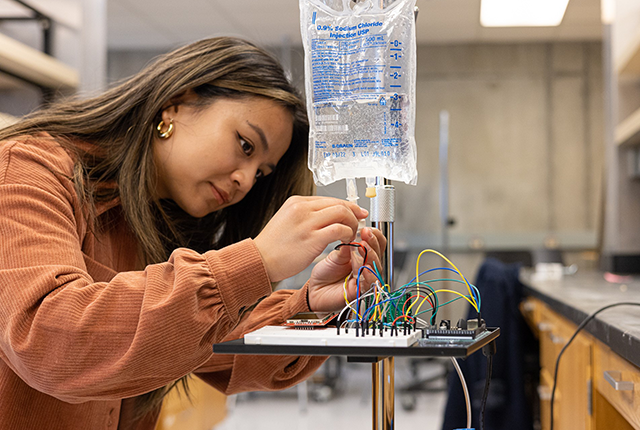
UW students design low-cost IV monitor for newborn care
Designed for use in low- and middle-income settings, the device is twice as accurate as similar commercial monitoring systems.A team of undergraduate students in the University of Washington Department of Electrical & Computer Engineering (ECE) has developed a low-cost device to monitor the flow of intravenous fluids for use in low- and middle-income countries. The team was led by Dr. Gregory Valentine from the Department of Pediatrics at the UW School of Medicine.
Many sick or premature newborns need intravenous infusion of fluids, medication and nutrition to survive, but because of their small size, the rate at which they receive IV fluids and amount they receive must be carefully monitored. Many under-resourced countries lack affordable, accurate IV-monitoring devices.
Valentine, a neonatologist who conducts research on how to improve newborn health, says he saw the problem firsthand while working in Malawi, where there weren’t enough working IV pumps for all the babies. “When I was in Malawi, I saw babies die — at one point, two to four babies a day. Most lost significant weight within two to three days after birth and became severely dehydrated without access to IV fluids.”
To help address this need, Valentine consulted with medical colleagues in Malawi and in 2019 partnered with the UW Engineering Innovation in Health program. Through this program, Valentine has been leading teams of students from ECE and mechanical engineering to develop a low-cost IV fluid pump and monitoring system that would be highly accurate. In 2020, the project received a $50,000 CoMotion Innovation Gap Fund Award, which assisted with prototype refinement and development.
In 2021, Valentine connected with ECE Professor Denise Wilson, whom he brought into the team to help oversee prototype development and publish research findings. Wilson is an expert in sensor systems and engineering education research. She is also the the department's associate chair for diversity, equity and inclusion.
Valentine, Wilson and three ECE undergrads who worked on the project recently published a description of their prototype in IEEE Sensors Letters.
The device is called H2neO, which stands for “Hydration to Neonates.” It uses technologies to detect not only drip rate but also the shape of the drops, making it twice as accurate at monitoring low drip rates as existing commercial IV monitors.
The prototype also can run on rechargeable solar batteries, which lowers costs and allows its use in settings where electricity is unavailable or unreliable.
Valentine said that while the team’s original intent was to design a device for under-resourced areas, H2neO could also help to save lives in high-income nations — for example, in rural communities, during military deployments, or after a natural disaster such as a hurricane or an earthquake.
Note: This is a condensed version of a longer article posted by the UW Department of Electrical Engineering.
For details about UW Medicine, please visit https://uwmedicine.org/about.
